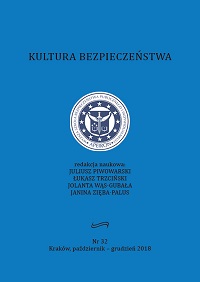Level of economic security of NATO Eastern flank countries
Level of economic security of NATO Eastern flank countries
Author(s): Agnieszka Sałek-ImińskaSubject(s): Security and defense, Military policy, Peace and Conflict Studies
Published by: Wyższa Szkoła Bezpieczeństwa Publicznego i Indywidualnego “Apeiron” w Krakowie
Keywords: economic security; GDP; the states of the eastern flank of NATO
Summary/Abstract: In the modern world an undoubted increase in the economic factor of maintaining the security of states is observed. Economic security is an important element of the functioning of national economies, including the states of the eastern flank of NATO. Perceiving economic security as a balance of development needs of these states we can identify several areas of activity of its quantifiers, which can include development, infrastructure and balance opportunities and needs. To determine the levels of these quantifiers, we must use a carefully selected set of meters. One of them is Gross Domestic Product (GDP) which clearly describes the measurable features present in the analyzed national economies. The objective of this article is to attempt to indicate the level of the economic security of NATO’s eastern flank states in terms of the level of economic growth measured by GDP. From an autonomous perspective, this meter does not give grounds for expressing value judgments in the context of the widely understood level of economic security, but it constitutes their necessary component and basis for further analyzes and evaluations. For the needs of the elaboration, an assumption was made, being a simplification of the economic reality, indicating that changes in annual GDP will show the level of the economic security of NATO’s eastern flank states. Hence, an increase in GDP growth lower than 1.9% in a period, which the analysis refers to, is a sign of a decrease in the level of economic security of a given state and vice versa. In all the states of NATO’s eastern flank, an improvement in its level was observed, where in 2017 in all the states of NATO’s eastern flank the rate of GDP growth was higher than the assumed critical threshold level of 1.9%. Years 2014–2016 also constitute a period of improvement in the level of the economic security of the analyzed states, except for Bulgaria in 2014, Estonia and Lithuania in 2015 and Estonia in 2016. While the period from 2008 to 2013 is a period when the level of the economic security of the states of NATO’s eastern flank is diverse and there are no indications that it improved. In the context of the analyzed problem, the best years were 2008 and 2011, for which GDP growth was the highest. In 2008 Estonia, Latvia and Hungary were those that did not reach the critical threshold (decline in economic security). The other six states were characterized by an increase in the level of economic security. The following year is a period when all the states (except for Poland) did not register any improvement. This resulted from a general economic recession, which was observed in the region of Central and Eastern Europe. Considering the number of years for which the assumed critical threshold level of 1.9% was not reached, we can claim that the economy of Poland (2 periods: 2012–2013), and then Czech Republic, Lithuania, Latvia and Slovakia (3 periods), Romania (4 years) and Bulgaria, Estonia and Hungary (5 years) were characterized by the highest level of economic security in the analyzed period.
Journal: Kultura Bezpieczeństwa. Nauka-Praktyka-Refleksje
- Issue Year: 2018
- Issue No: 32
- Page Range: 202-221
- Page Count: 20
- Language: English

